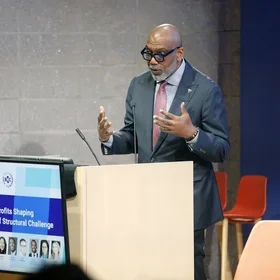By Dr. Steven Cohen, Senior Vice Dean, School of Professional Studies; Professor in the Practice of Public Affairs, School of International and Public Affairs
I always thought energy efficiency was the low-hanging fruit of environmental sustainability. Who could possibly be in favor of wasting energy? Wasting energy was like throwing away money. Why would anyone want to throw away money? Recently, I learned that America’s home builders don’t mind throwing away money as long as it isn’t theirs and instead belongs to their customers. The argument is presented in a Washington Post piece written by Anna Phillips last week. According to Phillips:
“…developer Ron Jackson said he is building what America needs — more affordable homes for the nurses, police officers and teachers struggling to find housing they can afford amid a nationwide shortage. That’s why Jackson and others from North Carolina’s home building industry say they came out in force last year against a state plan to tighten energy efficiency building codes so new homes would waste less energy, reducing their carbon footprints. The builders succeeded in blocking the new standards, helping to maintain the status quo. “All that energy code was going to do in my price range is make it to where the working man and woman would not be able to buy a home,” Jackson said. He sells homes in the $250,000 range and estimated the changes would have increased his costs by more than $20,000 — a figure that comes from a survey of North Carolina builders conducted by the state branch of the National Association of Home Builders, the housing industry’s largest lobbying group… There’s no debate that boosting the energy efficiency of new homes often increases upfront costs, but the builders appear to be inflating the numbers. A federal study found that North Carolina’s proposed code update would have added at most about $6,500 to the price of a newly built home, not $20,400.”
Whether it costs $20,000 or $6,000, builders don’t like to be told what to do and, throughout the county, are resisting building codes that require better insulation, energy-retaining windows, and other methods that enable homes to be heated or cooled with less energy. Their argument is that a higher capital price makes the home too expensive to buy. Of course, higher operation and maintenance costs make a home too expensive to keep. An important element of the discussion is that the builders resisting energy efficiency simply don’t want to rethink how they build homes and are conceptualizing the energy efficiency steps as an add-on to standard designs. In contrast, green builders are emerging who are rethinking home construction from the ground up. In some cases, the additional costs are nominal, while in other cases, they can be substantial. But in all cases, green buildings reduce the energy it takes to operate a building. In my view, the objection from developers seems to be that the government is trying to use building codes to require construction techniques that builders do not see as essential.
The use of building codes to ensure that buildings are safe and disaster-resistant seems to be less controversial than codes related to energy. Building standards to survive earthquakes, fires, and floods seem more acceptable than codes that help save energy and water. Still, the opposition to energy standards seems to be a form of almost deceptive pricing. Yes, your monthly mortgage costs are lower, but your energy costs are higher. As Phillips reports in her Washington Post piece:
“Supporters of stronger efficiency measures, such as thicker insulation, better windows and tighter air sealing, say they pay for themselves through lower heating and cooling bills. A federal analysis of the 2021 code found that while the payback period varies in different parts of the country, on average, homeowners would recoup their costs in 10 and a half years.”
The pricing strategy reminds me of the tendency of less informed consumers to buy huge bottles of laundry detergent, mostly filled with water, which appear cheaper than concentrated detergent—even though the cost per load of laundry is lower with the concentrated detergent. The monthly cost of a home is not limited to the purchase price. It includes taxes, utilities, and maintenance. If reducing one cost increases another, you are not really impacting affordability.
The resistance to energy efficiency building codes can be seen as a part of conservative opposition to environmental regulation, indeed to all regulation. In New York City and California, building codes and regulations are advancing energy efficiency and decarbonization, but in other parts of America mistrust of government is the norm. Increased opposition to environmental rules means that for the trend toward green building to grow in “red state” America, the market will need to stand on its own. While the data is often contested, there is some evidence that the benefits of green building outweigh the costs, although that is for someone who purchases and lives in a green building rather than for the developer who is simply trying to minimize the time from construction to sale while maximizing profit.
Even though America’s home builders may be resisting energy efficiency, there are a number of other forces in our society moving in the other direction, promoting energy efficiency. Electric utilities, in part in response to regulatory requirements but also in part to make the energy system more efficient and cost-effective, have been promoting energy efficiency. As the cost of generating and distributing energy increases, one way to keep consumer costs from rising is to reduce waste and increase system efficiency. With digitized electric meters, it is possible to charge consumers less for energy used during non-peak use periods, encouraging people to wash dishes or clothes or charge their vehicles late in the evening. This helps ensure that all the energy generated is used and prevents strain on the grid. In New York City, the capital costs and political challenges of siting a new power plant have been avoided by promoting and even subsidizing energy efficiency expenditures.
Numerous states and cities, along with the federal government, have been ensuring that government buildings under their direct control increase their energy efficiency. This includes retrofits of old government buildings and ensuring that new buildings are built using green building materials and technologies. One policy objective for energy efficiency is a reduced carbon footprint, but another is reduced energy costs to consumers. More cost-effective and energy-efficient buildings help a city compete for businesses and residents. Energy efficiency has helped the U.S. economy grow by enhancing productivity. According to Lora Shinn of NRDC:
“Using less energy is good for your wallet… and the broader economy. Thanks to efficiency measures, U.S. energy use is about the same now as it was more than 20 years ago, even as the economy has steadily grown. Greater efficiency can also relieve stress on the power grid and infrastructure.”
The long-term importance of energy efficiency is clear, but it is important to understand that there are short-term competing interests that may sometimes make it difficult to pursue energy efficiency and decarbonization goals. The builders interviewed in the Washington Post piece are trying to build homes that working families can afford. In their view, they don’t need additional pressure on costs. In some places, the costs of energy efficiency could add to housing costs and exacerbate the problem of homelessness. These trade-offs require climate advocates to understand that climate change is not the only problem we face. Poor children may not have a home, and hard-working families are struggling to buy a home. Still, one role of government is to make it possible for builders to keep their prices down while achieving environmental goals. Perhaps the tax system can be used to help subsidize the capital costs of energy efficiency, with pay-back when the investment has paid off. We ought to be able to achieve the goals of housing all Americans and making their homes more energy-efficient.
Views and opinions expressed here are those of the authors, and do not necessarily reflect the official position of Columbia School of Professional Studies or Columbia University.
About the Program
The Columbia University M.S. in Sustainability Management program offered by the School of Professional Studies in partnership with the Climate School provides students cutting-edge policy and management tools they can use to help public and private organizations and governments address environmental impacts and risks, pollution control, and remediation to achieve sustainability. The program is customized for working professionals and is offered as both a full- and part-time course of study.



